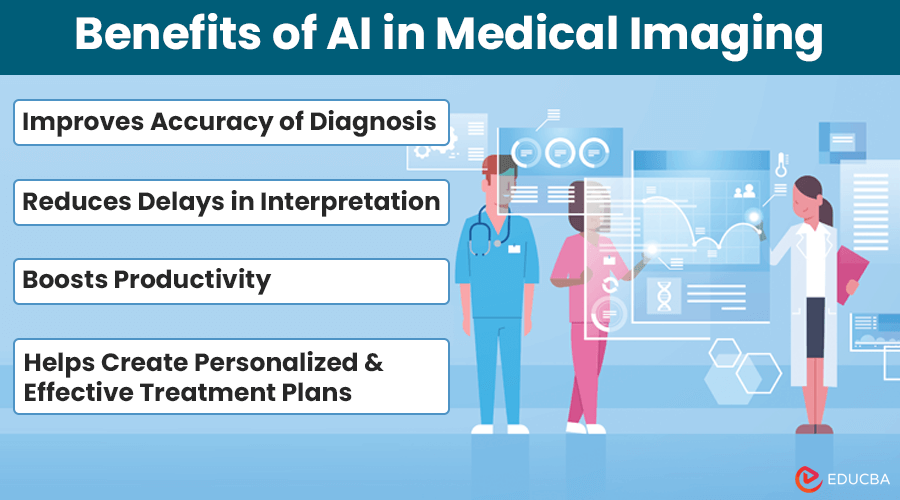
How is AI in Medical Imaging Benefiting Healthcare?
AI in medical imaging means using artificial intelligence technologies, like machine learning, to assist radiologists and clinicians in interpreting medical images and making diagnoses.
Modern healthcare relies heavily on medical imaging for diagnosis and reports. However, the traditional imaging processes are tedious as the radiologists have to interpret the complex imaging data manually. This can lead to delays, errors, and variations that don’t make the diagnosis accurate. As a result, the patient waits longer or gets hold of the wrong diagnosis, which impacts their treatment plan.
AI in medical imaging can help overcome these pain points and automate the process. It can make the entire diagnosis efficient, offering great breakthroughs to users. About 19% of healthcare organizations stated they are working on developing AI models, while 18% are assessing the possible use cases. Furthermore, healthcare experts can also customize healthcare software according to their needs to elevate patient outcomes.
In this article, let us see how AI in medical imaging improves healthcare services.
What is Medical Imaging?
Medical imaging, or diagnostic imaging, helps doctors get a complete visual assessment of the patient’s internal anatomy to identify and understand any issues. This method helps collect vast amounts of data, which healthcare workers like diagnosticians analyze and interpret. It helps them better understand the patient’s condition and extend the correct treatment plan. The doctors get a complete understanding of the possible treatments for the patient’s diagnosed condition.
Here are some types of diagnostic/medical imaging techniques:
- X-ray, based on electromagnetic radiation, produces a detailed image of the bones and soft tissues to diagnose internal fractures and infections.
- MRI (Magnetic Resonance Imaging) uses radio and magnetic waves to create images of soft tissues, organs, and blood vessels.
- A CT scan allows your doctor to get a complete visual of the internal body structures to find vascular abnormalities and injuries.
- Ultrasound provides real-time images of the internal organs and tissues.
How Can AI in Medical Imaging Help?
➔ Challenges of Traditional Diagnostic Methods
Healthcare professionals face several challenges with the traditional diagnostic methods, such as:
- The cost of the equipment and its maintenance is high.
- If the image quality is not up to the mark, it can lead to inaccurate interpretations.
- Patients need to wait for long hours to get the diagnosis.
➔ Benefits of AI in Medical Imaging
Using artificial intelligence in medical imaging has the following benefits:
#2. AI-Assisted Image Interpretation Helps Create Personalized & Effective Treatment Plans
Healthcare professionals, including radiologists, manually examine images for anomalies. AI can serve as a helpful assistant, automating tasks and allowing radiologists to focus on treatment rather than understanding patterns.
AI can segment the structures, determine the key parameters worth studying, and identify the features important for diagnosis. It can also highlight the portions of the image that seem concerning, reducing the need for manual intervention. It is also easier to personalize the treatment when artificial intelligence can predict the progression of diseases and identify the best treatment plans.
#3. Integration with Diagnostician’s Workflow Boosts Productivity
One of the biggest issues patients face with diagnostic imaging is the delay in receiving the results. It takes hospitals a lot of man-hours to send out the actual diagnosis to the patients.
However, with AI, radiologists can define and automate workflows for repetitive tasks, such as image pre-processing. This way, AI can easily streamline the entire diagnosis process, reducing the turnaround time and improving patient care. Additionally, it can integrate with the EHR (Electronic Healthcare Records) system to foster better data management and accessibility.
This would free healthcare professionals to focus on complex cases and prepare treatment. This efficient workflow management can reduce patient wait time and enhance outcomes.
#4. Advanced Imaging Techniques Reduces Delays in Interpretation
Accurate diagnosis relies on interpretation, but manual analysis can be prone to errors. Integrating AI with advanced imaging technologies boosts efficiency and accuracy.
For example, deep learning algorithms enhance image reconstruction from low-dose scans, improving interpretation while lowering radiation exposure. Additionally, AI fusion techniques combine various imaging modalities, providing valuable insights for healthcare practitioners.
Challenges and Limitations of AI in Medical Imaging
Integrating AI with diagnostics imaging is one of the best advancements in healthcare. However, this is not devoid of challenges or limitations.
#1. Data Quality
Implementing AI in imaging techniques requires training sets that help AI recognize anomalies or issues in the diagnosis. Developing these training sets is usually challenging and requires large datasets of high-quality data. Moreover, data standardization is also necessary for effective outcomes.
#2. Regulatory and Compliance Challenges
The regulatory realm for AI in healthcare is in the preliminary stages. Your solution must ensure compliance with GDPR (General Data Protection Regulation) and HIPAA (Health Insurance Portability and Accountability Act).
Integrating these aspects can be challenging and time-consuming. You may also face significant issues while incorporating these compliances due to the lack of clear guidelines.
Final Thoughts
Artificial intelligence can enhance diagnostic accuracy, enabling efficient healthcare delivery. This gives practitioners and healthcare professionals a complete understanding of the issue, enhancing the treatment processes.
The challenge lies in creating enough data sets and adhering to regulatory compliances. So, you must take the necessary steps to ensure adherence to niche-specific compliances and regulations.
Recommended Articles
If this article on AI in medical imaging helped solve your queries or learn something new, explore our other related articles for further insights.

